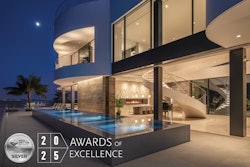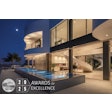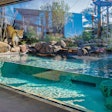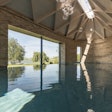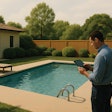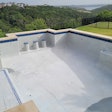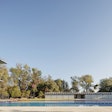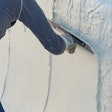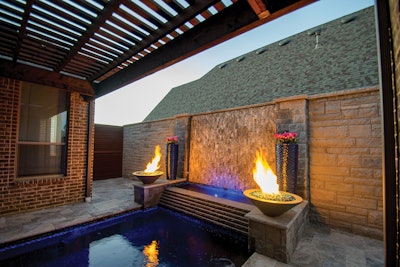
Tight quarters demand forethought and precision. It's like three people in a tiny studio apartment. You have to plan your moves. There's someone in the bathroom and someone in the kitchen, so you sit on the couch and look for an opening. As you pass, you steer a narrow course.
It's the same for building in small backyards. To get the pieces to fit takes advance planning, spatial awareness and execution. For builders, those skills grow in value every year, as the population grows, backyard spaces get a little bit smaller and the universe of exciting features gets a little larger.
To bridge the gap between more features and less space takes an experienced and gifted designer, such as Mike Farley, SWD and ASLA. (Farley teaches a popular class on the subject. He hosts an enjoyable podcast and tells a good story, too — some of which are included in block quotes below.)
Farley doesn't use the word "tricks." Perhaps "tips" is a better word, but there's no denying the job requires cunning maneuvers to outwit the strict confines of space. In summarizing these, Farley begins by emphasizing some common sense principles of design, beginning with the importance of upstream knowledge.
If you're not thinking ahead, you can build yourself into a corner and dash a client's dream (or be forced to ask for project bail money). It's just so important that the client understands the limitations of a tiny backyard upfront, he says, before an impractical dream has taken root.
NO. 1 - AVOID THE LAND MINES AHEAD
We all know to stay out of trouble at work. A corollary for small space building could be to "learn where the land mines are, and avoid them."
In small backyards, the property lines may be close, but the setback requirements set forth by the local jurisdiction or HOA are always going to set the linear limits for the project, along with what the landscape itself may dictate in terms of drainage or subterranean surprises, so doing your homework up front will save tears and stress down the road.
"I try to understand everything about the property before the first meeting," Farley says, "the quirks that it has, and especially what the city will allow. Every city's different, and each one has different rules for different lots, corner lots, interior lots, lots with alley access. You don't want to find out what those are later on."
And don't forget utilities. There are always rules and setbacks for electrical lines, he adds. "Say you've got power lines in the rear alley. Well, you have to be a certain distance away from them, let's say it's 17 feet, because of the voltage that's going through the line. The only way to know exactly how far away you need to be is to call the electrical company because it's based on the voltage in the line. You can't see what voltage is in it, so you have to call the utility."
Thus, you find the true boundary for building, which is crucial to assembling the jenga puzzle of vessels and features:
"If you have a half acre, it's no big deal, but if your backyard is only 30 feet deep, and you need to be 10 feet from the back line, and 17 feet from a power line on the side, well, that's a pretty big deal.
"So we had one project recently where they allowed us to get a little closer by wrapping the lines in a fabric cover. They're like, 'Yeah, for $2,500, we can come out here and wrap these lines and instead of 17 feet away, now you can be 8 feet away.'"
"My client's like, 'Sold!" Let's wrap the lines!' So we did."
[Note: Their concern is the line breaking and falling into the pool. If they wrap the lines and a line breaks, then it stays in the wrapping and can't fall in your water.]
AVOIDING LAND MINES, PART II. SITE ANALYSIS.
Half the battle is what the municipality will demand, but the other half is what the site demands, as Farley explains:
"So site analysis is crucial. It's boring, but it's crucial. In the pool industry, the biggest site issue is grades and hillsides and slopes. And if you don't understand very clearly what you've got in terms of grades, you will start getting calls from angry pool owners after the build.
"We get them all the time from people who bought a pool from someone who didn't understand the contours of the property, and now they're on the phone saying, 'Hey, how do we fix this?'
"And the problem is, they did business with somebody who gave them a 3D model that looked good on a screen or on paper, but it wasn't accurate. This is sometimes due to what's called 'cross-slope.'
"When a lot of pool designers go to measure the yard, they'll start at the back door, and they'll go straight to the back fence right in the middle to shoot the grades. Well, the problem is the right side of the yard is 2 feet higher than the point you used to shoot the grades, and the left side of the yard is 2 feet lower than that. So you have a 4-foot elevation change from one side to the other — that's your cross slope.
"So nothing's going to work when you start laying it out later on. And once you're working to a bad model, it's always, 'Well, the superintendent's the bad guy because he's telling them this won't work, and the pool designer's gone to work for somebody else, and now they're stuck with a problem that they're trying to fix because someone didn't accurately understand the site.'
"Site analysis may be a tiresome task, but here's the thing: Everybody's going to be happy if you do a good site analysis. Because you're going to have a whole lot less change orders, and fewer surprises during construction. That means the company makes more money, and you get a better referral. And nobody's frustrated and saying bad things about you."

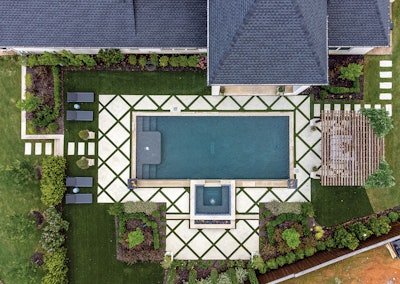
 Three small properties, three captivating spaces for people to enjoy themselves outside.
Three small properties, three captivating spaces for people to enjoy themselves outside.
NO. 2 - ESSENTIAL VARIANCES
Small space builders need variances from time to time. If you have 2 acres to work with, you can meet every setback and space requirement code no problem. But in a wee little backyard, every dimensional foot matters, and variances can have a large impact on the success of the overall project.
A tiny backyard designer needs a strategy for getting the best outcome out of government officials — some of whom may be bored, distracted, disinterested or even malicious. Or they may be dedicated, helpful and reasonable, even susceptible to charm, you just don't know. Farley tells this story:
"I just did a project where the city code is 6 feet from the house to water. And this city has always been hard line and inflexible when it comes to codes.
"But we really needed more space in this pool. And so I was like, 'Well, it doesn't hurt to make a phone call.' So I made a phone call and said, 'Hey, I know the code, but we've got an engineer that says it's okay.' And they're like, 'Yeah, no problem.' And I was shocked! I said, 'Well, I've only dealt with this city for 20 years.' And they're always like, 'No, it's 6 feet to the water, period, no exceptions, every time.'
"So you never really know until you try. We ended up getting what we needed, and all it took was a phone call and an engineer to sign off.
"Here's what I've found in dealing with the city. You send somebody an email about a variance, and the answer is no. That's your answer.
"And that's the way most of the people work today — they send an email because it's easier. And that email makes it easier for the person on the other end to just say, 'No, that's not our standard procedure.' Click, end of story.
"The phone is better, but if you really need it, I'm going to walk down to their office, put my smiley face in front of theirs, and try to come up with a reasonable solution. And if you do that, sometimes they'll be reasonable."
 Versatility saves space. This counter works for both kitchen and pool.
Versatility saves space. This counter works for both kitchen and pool.
NO. 3 - BORROW PRIVACY AT LOW RATES
There are lots of things you can do on a property to save space and provide the features customers demand. For instance, everybody needs privacy. They don't want to see their neighbors when they're sitting in their hot tub. But maybe their neighbors don't want to see them, either, and have already built a solution.
Farley calls it borrowed landscaping: using the shrubs and trees and structures in a neighbor's yard to help create privacy for your client:
"So you have to look at what you can borrow from your neighbor and think about what it's going to look like in a year or two. A lot of times, I'm dealing with new construction, so those plantings you can see in the neighbor's yard are going to grow and do a better job of screening all the time.
"Privacy is especially important with certain features like spas and fireplaces. I had one project where the neighbor's bathroom window lined up right across from where we were going to put the spa. And so, we put a fireplace right there right next to the spa, which then lined up with their window, so they looked at the back of the fireplace instead of into the spa.
"You have to think strategically about what you're putting in that might be able to block the neighbor's view. To that same point, you have to think about where the neighbor's windows are.
"When I design, I photograph the neighbor's windows so I can design and build to that. Sometimes, we've done three-dimensional models from Google Earth, put the footprints of the five houses that surround the backyard — three across the back and one on each side — and then put the windows in the houses. And then we're like, here's how we're going to screen or block those.
"Instead of putting in a raised spa, sometimes we make the spa flush to help with the design. It's lower now, which changes the sight lines when you're in the spa, and now, we have more space to walk between the house and the spa. If the spa's flush, I have 5 feet of walkway space. If I raised the spa, I only have 3 ½ feet to walk through there. And 1 ½ feet is a lot in a tiny backyard."
THE JOB OF THE SMALL SPACE DESIGNER/BUILDER
As more people pack into tighter urban spaces, pool builders are putting vessels on smaller properties, but clients still want the features they've seen in bigger backyards. They don't naturally consider the space constraints. The job of the designer/builder is to make them think about priorities.
"'Can you get everything I want in this tiny backyard, Mike?' 'Well, no, not all of those things. We'll have to set some priorities.' And I make them think about their priorities so I can get the most important things in. And here's the thing: As a designer, you tend to want to make the water the most important thing — we sell swimming pools. But that's not my job. My job is to solve their problems. And if that means we need to cut 3 feet of pool to get a screen in so they have the privacy they want most, so be it.
"There are certain designers that are like, 'No, this is my art palette, and I'm going to design the best thing in the world from an artistic standpoint.' And that's not wrong, but it can be wrong for your client.
"Here in Texas, the pool market is very family driven. What most people want here is an ideal backyard for teenagers to hang out in because they want to watch and see what the kids are doing. They don't have an ocean to look at. They don't have this great vista over the Tennessee mountains. They have a backyard fence.
"I believe I am here to serve their interests. If that's art, that's great. Some designers are all about form, but my customers mostly want function. Some people give me crap. They're like, 'Man, you're always putting slides on pools, and those things are ugly.'
"You know what? My clients love 'em."
This article first appeared in the April 2025 issue of AQUA Magazine — the top resource for retailers, builders and service pros in the pool and spa industry. Subscriptions to the print magazine are free to all industry professionals. Click here to subscribe.



























